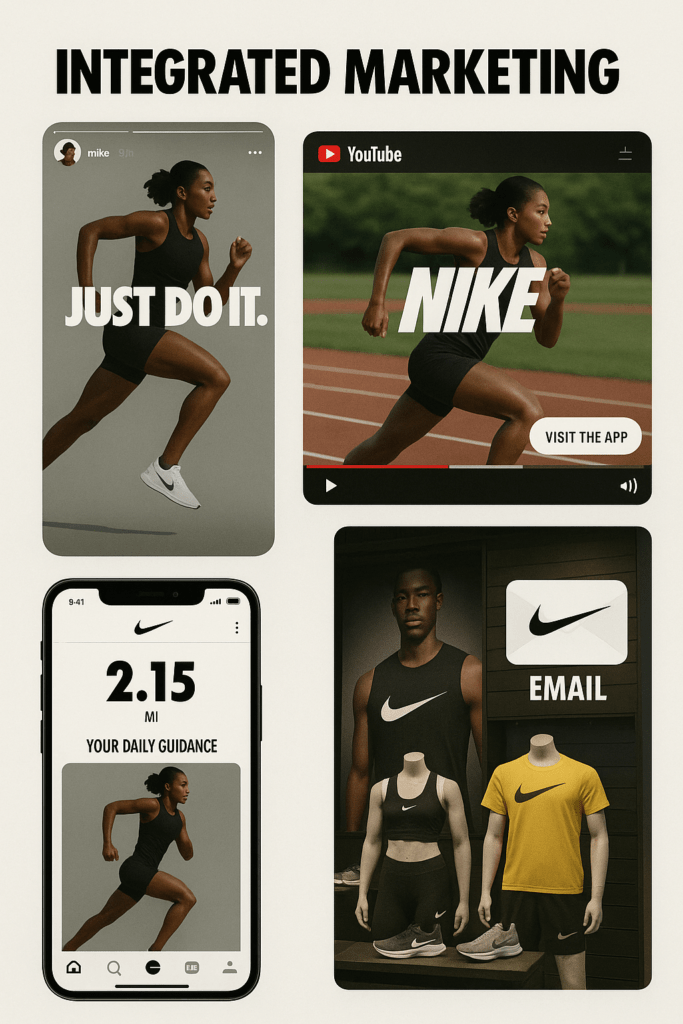Integrated Marketing:
Create Seamless Brand Experience

In today’s marketing landscape, integrated marketing has become essential for brands trying to stand out in an oversaturated market. Walk through any busy street or scroll through your phone for five minutes, and you’ll be hit with dozens of marketing messages.
Digital marketing strategies plays a very crucial part for every brand, who make the best strategies wins. Instagram ads, email notifications, billboards, podcast sponsorships—brands are everywhere, competing for attention in an increasingly crowded space. You can read the best proven digital marketing strategies here.
But here’s what I’ve noticed after years of working with different brands: the ones that succeed aren’t necessarily the loudest or the ones with the biggest budgets.
They’re the ones that feel consistent no matter where you encounter them. When you see their Instagram post, visit their website, or walk into their store, everything feels connected. There’s no jarring disconnect that makes you wonder if you’re dealing with the same company.
This consistency doesn’t happen by accident. It’s the result of integrated marketing—a strategic approach that treats all your marketing channels as parts of a single, coordinated effort rather than separate campaigns running in parallel.
Integrated marketing ensures that whether a customer discovers your brand through social media, search engines, or word-of-mouth, they experience the same core message and brand identity.
Most businesses struggle with this. They’ll have their social media team running one type of campaign, their email marketing following a different strategy, and their website telling yet another story.
The result? Confused customers who aren’t sure what the brand actually stands for.
In this article, we’ll break down what integrated marketing really means, why it’s become essential for business success, and how you can implement it without overhauling your entire marketing operation.

What is Integrated Marketing?
Integrated marketing is essentially about getting all your marketing efforts to work together instead of against each other.
Instead of running separate campaigns across different channels, you create one cohesive strategy that adapts to each platform while maintaining the same core message and brand identity.
Think of it this way: if multichannel marketing is like having different people tell different stories about your brand, integrated marketing is like having one skilled storyteller adapt the same story for different audiences. The plot stays the same, but the way it’s told might change depending on who’s listening.
The difference is significant. A multichannel approach might have your Facebook ads promoting one product feature, your email newsletter focusing on customer service, and your website highlighting pricing—all perfectly valid messages, but potentially confusing when experienced together.
An integrated approach would ensure all these channels support the same primary message while highlighting different supporting points.
This doesn’t mean every piece of content needs to be identical. Your Instagram posts will naturally look and sound different from your email newsletters. But the underlying brand voice, visual identity, and core message should be recognizable across all of them.
Also read: How to Convert Clicks to Customers? Guide to Optimizing Landing Pages

Key Benefits of
Integrated Marketing
Stronger Brand Recognition
When customers encounter consistent messaging and visuals across different touchpoints, they start recognizing your brand immediately. This recognition builds over time and makes your marketing more effective because people don’t have to work to understand what you’re about.
Increased Trust and Credibility
Inconsistency makes brands appear disorganized or unreliable. When everything feels connected and intentional, customers are more likely to trust that you’ll deliver on your promises. This trust translates directly into higher conversion rates and customer loyalty.
Better Use of Marketing Budget
Instead of creating completely separate campaigns for each channel, integrated marketing allows you to repurpose and adapt content across platforms. You spend less time and money on production while getting more mileage from each piece of content you create.
Clearer Performance Insights
When all your marketing efforts support the same goals, it becomes easier to understand what’s working and what isn’t. You can see how different channels contribute to the overall customer journey rather than trying to evaluate each one in isolation.
More Effective Customer Journey
Customers rarely convert after just one interaction with your brand. Integrated marketing creates a smoother path from awareness to purchase by ensuring each touchpoint builds on the previous ones rather than starting from scratch.
Also read: How to Convert Clicks: Guide to Improve Ecommerce Landing Pages
Core Components of an Integrated Marketing Strategy
Unified Brand Message and Voice
Before you can integrate anything, you need to be clear about what your brand stands for. This goes beyond your tagline or mission statement.
It’s about understanding the tone you use, the values you emphasize, and the personality you project. This foundation needs to be documented clearly enough that anyone creating content for your brand can apply it consistently.
Strategic Channel Selection and Connection
Not every brand needs to be on every platform, but the platforms you choose should work together strategically. Effective digital marketing really helps.
Your email marketing might drive traffic to specific landing pages, which then encourage social media follows, which expose people to retargeting ads. Each channel should have a clear role in the overall customer journey.
Visual and Creative Consistency
This is often the most visible aspect of integrated marketing. Your colors, fonts, logo usage, and overall design aesthetic should be recognizable across all platforms.
But consistency doesn’t mean boring—you can adapt your creative approach for different platforms while maintaining visual coherence.
Data and Analytics Integration
To truly integrate your marketing, you need to understand how different channels influence each other. This requires tracking tools that can follow customer behavior across touchpoints and attribution models that give you a complete picture of campaign performance.
Also read: Launch Your Facebook Ads Campaign Without Wasting Budget

Real-World Example:
Nike’s Integrated Approach
Nike provides an excellent example of integrated marketing in action.
Whether you encounter their brand through a Instagram story, a YouTube pre-roll ad, their mobile app, or a physical store, you’ll experience the same motivational tone, bold visual style, and focus on athletic achievement.
But Nike’s integration goes deeper than consistent branding. Their digital campaigns often connect directly to their app, which tracks personal fitness goals and recommends products.
Their retail stores feature the same athletes and campaigns you see in their advertising. Their email marketing personalizes recommendations based on your app activity and purchase history.
Each touchpoint feels distinctly like Nike, but more importantly, they all work together to create a complete brand experience that goes far beyond individual marketing messages.

Measuring Success in
Integrated Marketing
Measuring integrated marketing requires looking beyond individual channel metrics to understand overall campaign performance:
Brand Awareness Metrics
Track increases in branded search volume, direct website traffic, and unprompted brand recognition surveys. These indicate whether your consistent messaging is building brand recognition.
Cross-Channel Engagement
Monitor how customers move between your different marketing channels. Are email subscribers also following you on social media? Are social media followers visiting your website? This behavior indicates successful integration.
Conversion Attribution
Use tools that can track the complete customer journey across multiple touchpoints. This helps you understand which combinations of channels are most effective at driving conversions.
Customer Lifetime Value
Integrated marketing should result in stronger customer relationships, which typically translate to higher lifetime value and retention rates.
Marketing Efficiency
Compare the cost and time required to produce your integrated campaigns versus previous multichannel efforts. Successful integration usually results in better resource utilization.
Use platforms like Google Analytics, HubSpot, or Salesforce to gather data across all your marketing channels. The goal is to create a unified view of campaign performance that shows how different elements work together.
Common Challenges and
How to Address Them
Organizational Silos
Many companies struggle with integrated marketing because different teams manage different channels. The social media team might not know what the email marketing team is planning, leading to disconnected efforts.
Solution: Regular cross-team meetings and shared planning calendars help ensure everyone understands the overall strategy and their role in it.
Platform-Specific Requirements
Different platforms have different content requirements, audience expectations, and optimal posting strategies. It can be challenging to maintain consistency while optimizing for each platform.
Solution: Focus on consistent messaging and brand voice while allowing creative execution to vary by platform. Your LinkedIn posts will naturally look different from your TikTok content, but they should feel like they come from the same brand.
Resource Constraints
Integrated marketing can seem resource-intensive, especially for smaller businesses that are used to focusing on one or two channels at a time.
Solution: Start small with integration between your most important channels, then expand gradually. Even integrating just your email marketing and social media can produce significant improvements.
Also read: How to Master Google Ads for Digital Marketing Success?

Building Your Integrated Marketing Future
Integrated marketing isn’t about being everywhere at once—it’s about being consistent and strategic wherever you choose to show up. You can build a digital marketing career from here.
In a world where customers interact with brands across multiple channels throughout their buying journey, this consistency has become a competitive advantage rather than just a nice-to-have.
The brands that will thrive are those that can create seamless experiences across all touchpoints, where each interaction builds on previous ones rather than starting from scratch.
This requires planning, coordination, and a clear understanding of your brand’s core message, but the payoff in terms of customer trust, recognition, and marketing efficiency makes the effort worthwhile.
Start by auditing your current marketing efforts. Look for places where your messaging or branding feels disconnected, then work on aligning those elements.
You don’t need to overhaul everything at once—even small improvements in consistency can have a significant impact on how customers perceive and interact with your brand.
Also read: 4 Impactful Tips to Kickstart your Digital Marketing Career

